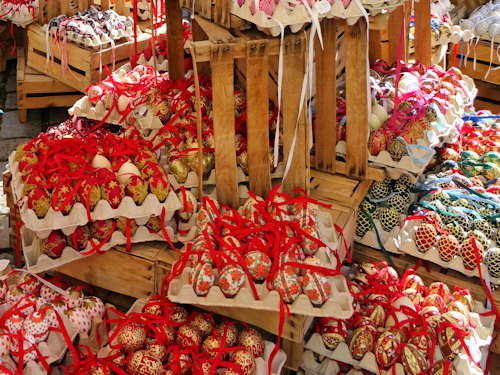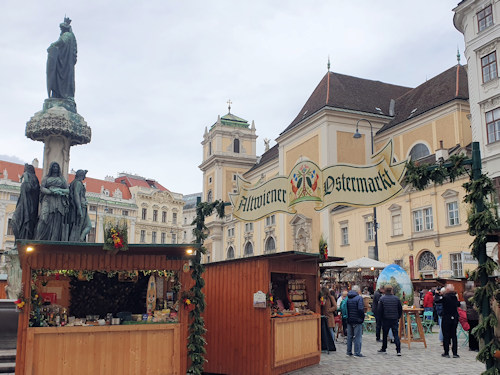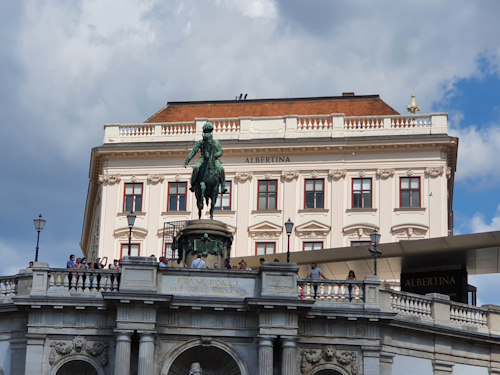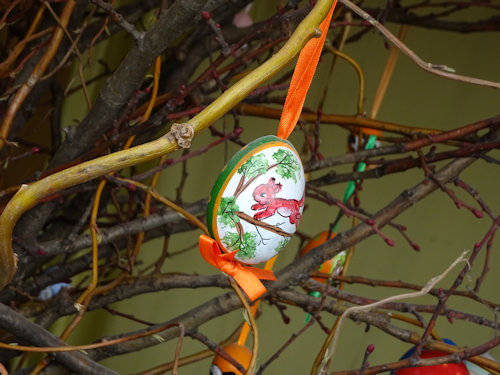
So, Easter, the time of frolicking lambs and, wait…no lambs in Vienna. But plenty else to make your trip enjoyable.
In fact, the rabbits rule the Easter menagerie – as you’ll notice if you enter any supermarket in the weeks leading up to the holiday.
Read on for details of Easter markets and events in Vienna, as well as tips on seasonal travel, weather, food, and traditions.
- Book a concert experience* for your trip
- See also:
- What to do in April
Jump to:
2025 dates

(Expect to see eggs)
Vienna has become a popular destination for an Easter city break. Visitors swap places with the Viennese, who often head to the Alps with the kids for a final ski before the spring sun ends the fun.
The official 2025 Easter (school) holidays here last from April 12th to April 21st. During this period, any children aged 14 or less travel free on the transport authority’s subways, trams, and buses.
Dates for the actual Easter weekend in 2025 are:
- Maundy Thursday: April 17th
- Good Friday: April 18th
- Easter Saturday: April 19th
- Easter Sunday: April 20th
- Easter Monday: April 21st (a public holiday)
The Easter markets

(The Easter market on the Freyung)
The Easter markets (Ostermärkte in German) head up the list of seasonal attractions and normally open from around two weeks before the Easter weekend.
Think of them as top-quality arts and crafts markets with the added bonus of historical locations, a truck-load of eggs, and several high-calorie pinches of regional cuisine.
As well as an enjoyable experience in their own right, the markets also make a decent source of unique souvenirs and gifts.
The top locations are:
- Schönbrunn: in front of the Habsburg summer palace
- Am Hof: very close to the city centre
- Freyung: near Am Hof and usually includes an organic farmer’s market
Easter events
The big museums had some spectacular exhibitions last time (Lichtenstein, Matta and Holbein were just three of the names on show) and I expect Easter 2025 to follow a similar pattern.
I await full schedules, but it seems we can already look forward to:
- A special Klimt exhibition at Lower Belvedere, exploring the processes and materials behind his paintings
- An exhibition around the likes of Arcimboldo, Bassano and Bruegel at the Kunsthistorisches Museum

(Look for something good at the Albertina)
Explore your full options on the main exhibitions page.
For other activities over Easter, take a look at:
- The general concert venue page for tips on where to find a suitable classical concert
- The events summary page, which I update every seven days with selected highlights for the coming week
- My specific activity suggestions in the April “what to do” pages
Easter traditions
As far as family Easter traditions go, you only need to know two words: eggs and rabbits.
You paint, colour, decorate, hang up, or eat the eggs, though large chocolate ones in the UK-style are fairly rare.

(An Osterbaum or “Easter tree” with appropriate decoration)
The Easter rabbit brings the eggs in the first place. (Given my understanding of reproductive biology, I’m going to assume the rabbit doesn’t actually lay the things.)
Technically it’s the Easter *hare*. The German word for the animal is Osterhase, which derives from Ostern (Easter) and Hase (hare).
Learn more about Austrian Easter traditions here. In particular, discover why you hear the sound of a million hard-boiled eggs cracking in gladiatorial combat on the morning of Easter Sunday.
Easter food
There isn’t much. If you ignore the increase in the number of eggs appearing at mealtimes.
At least, the seasonal cuisine is nothing like Christmas, with its wide range of advent specialties.
Vast quantities of rabbit and egg-themed chocolate and candy dominate the supermarkets and the Easter table, of course.
I openly admit to a desperate obsession with Lindt’s Goldhase: chocolate rabbits in a golden livery, with a red ribbon and a little bell. A little bell!

(Easter chocolate, including some imports from the UK: mea culpa)
Apart from the chocolates and sweets, we have Osterschinken (Easter ham), which seems to be various varieties of normal ham with the word Easter added to the front. (But I might be wrong.)
We also have the Osterpinze (pictured below), which is a soft sweet pastry made from yeast dough.
Stores fill with other Easter-themed baked items, but most seem to be seasonal rebrands of products you get the rest of the year, too. Welcome to modern life.
I’ll make an honourable exception for the Osterstriezel, even though you do get Striezel all year. In days of yore, this braided brioche only appeared around All Saints’ Day and Easter.
(If I sound a little cynical, it’s because I am.)

(Osterpinze)
Easter travel & weather
The Easter period is still relatively low key when compared to Christmas. Easter Monday is a public holiday (on April 21st in 2025), when shops close. Otherwise, store opening hours are unchanged.
The same principle applies to public transport. A “Sunday service” operates on Easter Monday, but otherwise timetables remain unchanged.
However, since the week leading up to the Easter weekend is a school holiday, the “Ferien” timetables apply to trams and buses. This largely means slightly longer intervals in the morning, when kids no longer need transport to school.
Weather is a difficult one to call.
April in Vienna can see warmth and bright sun, but also late flurries of snow. Back in 2021, for example, we had snow on April 6th (which was the day after Easter Monday).
But with Easter 2025 relatively late in April, we should see decent spring-like temperatures. But who knows? Check (obviously) the forecast before you pack.
German tip
Finally, a quick language tip.
Easter is Ostern in German. So you find a derivative of that word appended to just about everything around the season. For example:
- Osterferien = the holidays
- Ostereier = the eggs
- Ostermärkte = the markets
- Ostersonntag = the Sunday of the holiday weekend
Have fun. And enjoy those Ostereier.